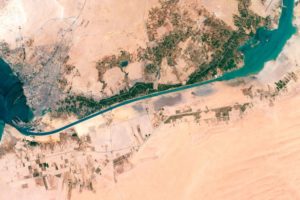For reasons of efficiency, the trade of the entire planet, and with it the global economy, depends mainly on four areas: the Suez Canal, the Panama Canal, the Strait of Hormuz and the Strait of Malacca.

The recent blockage of the Suez Canal, with a bill of $9.1 billion in goods for each day out of service based on Lloyd’s List estimates, made it clear that global trade flows along a less extensive path than one might think. Due to the search for efficiency in transportation, costs are lowered, however, in return, the dependence on these four strategic points, mentioned above, is very high.
According to World Trade Organization (WTO) data, $17.6 trillion worth of goods were transported in all of 2020. The Suez Canal, the Panama Canal, the Strait of Hormuz and the Strait of Malacca were key in moving this cargo. The Suez Canal Authority reveals that about 12% of the world’s goods transit through this passage, which, according to the specialized maritime logistics website Searates, avoids 6,400 kilometers of travel compared to the alternative route via the Cape of Good Hope, in southern Africa.
Malacca and Hormuz
Through the Strait of Malacca, the gateway between the Pacific and Indian Oceans, 25% of the world’s goods pass through every year. In the case of the Panama Canal, official sources report that approximately 3% of world trade passes through its system of locks. Among the differences with Suez, the Panama Canal serves mainly container ships rather than oil tankers. On a trip from the U.S. to Chile, Panama saves 7,400 kilometers of distance.

The last of the major strategic points, the Strait of Hormuz, measures its importance on a different scale from the rest. It is not so much the percentage of total goods, but the oil that crosses these waters off the Iranian coast. “According to our data, in 2020, 12.75 million barrels per day transited through Hormuz against the total of 37.75 million barrels per day globally. In other words, 34% of the oil transported through the sea around the world passed through this strait,” explained Vortexa, a firm specializing in energy market intelligence. “Thus, its capital importance lies in the fact that it is the main artery of oil flow in the entire planet”.

With a width of 33 kilometers at its narrowest point, the main threat to Hormuz is that of a war in the region. “The biggest risk is that the ships will be attacked as part of a regional conflict. If one were to arise between countries such as Saudi Arabia and Iran, or between any of the countries that make up the strained relations in the region, it would have a very serious impact on maritime trade. A military operation in the strait would put a third of the global oil supply out of action at a stroke,” comments Vortexa.

At the beginning of 2020, tension between Iran and the United States peaked after the assassination of Iranian General Qasem Soleimani. However, the arrival of Biden in the White House seems to have calmed tempers slightly, as talks have resumed to try to bring Iran back into the agreement restricting Iran’s nuclear development. Other funnels for the maritime transport of oil are the Suez Canal, the Turkish Straits, the Straits of Gibraltar, the Straits of Malacca and, finally, the Panama Canal.
Among the strategic points, those through which essential products such as energy are transported are the most sensitive. The greatest risks occur at those points where the alternative is not easily taken, either for economic or security reasons. On this basis, the Strait of Hormuz presents a special risk due to its geographical location, between countries in permanent political conflict. Navigation through this strait was already at risk during the Iran-Iraq war.
On the other hand, not having these arteries of trade would entail additional costs which, in some cases, may or may not be bearable. For example, if the price of fuel is sufficiently low and the logistics of the goods can assume longer transit times, the Cape of Good Hope is not only a viable alternative to the Suez Canal, but also highly recommendable. In other cases, as with the Panama Canal, it is difficult for the alternative to be cost competitive.
Strategic Points
Any impact on any of these four points or axes, such as the Suez and Panama canals and the Straits of Hormuz and Malacca, has a direct effect on a global level. Dependence on strategic points in global trade for the transport of goods where blockage episodes generate bottlenecks, as was demonstrated by the situation that generated a crisis in the Suez Canal, which shows the fragility of current supply chains, since what happened had a domino effect on supply chains not only in the short term but also in the medium term.
Experts point out that the strategy is to look for alternatives to complement maritime transport, the shipping method for 80% of the world’s total goods, according to data from the International Maritime Organization.
Experts believe that it is a fact that total security does not exist, and that all human activity involves certain risks. It is up to us as specialists to manage those risks in order to minimize the failures that may occur. About 12 billion tons of goods are transported by sea every year, more than 30 million tons per day, and the number of accidents with serious consequences is extremely low. Maritime transport is a safe mode of transport, as well as being the most energy efficient and environmentally friendly.

